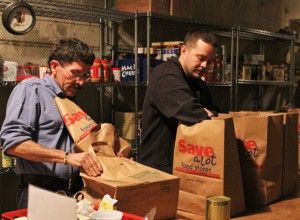Organizations help feed community
November 7, 2012
Directors see increased need in burdened economy
The Good Samaritan House of Carbondale, which serves as a food pantry and soup kitchen among other programs, did not receive any food from the St. Louis Area Food Bank for October.
The house receives a majority of its food from the food bank, a state-run organization that provides food from the U.S. Department of Agriculture to various food pantries.
Advertisement
Patty Mullen, assistant director of Good Samaritan Ministries, said more than half of the food received is from the food bank, and the pantry received its food for November.
Mike Heath, executive director of Good Samaritan Ministries, said the house is still losing food, though, and the number of people showing up to the pantry is increasing.
There was a 23.5 percent increase in families from 4,088 to 5,344 from fiscal year 2011 to FY 2012, he said.
Mike Morgan, a pantry volunteer for 11 years, said he has seen a significant increase in people who use the pantry in the last few years.
Many people like Sherry, who asked to not have her last name revealed, rely on the pantry to get by.
After a string of incidents that left her in financial difficulty, Sherry said a friend told her about the pantry in March. She said she gets food from the pantry so she can afford to buy her medicine.
“I was hungry,” she said. “I was eating a can of peas for breakfast until I found out about this.”
Advertisement*
Sherry said she normally makes soup and salad out of the chicken and canned goods she gets.
She also said she shares pantry items with a friend of hers who has no income.
While Morgan said he sees plenty of single individuals at the pantry, both Heath and Mullen said most people who use Good Samaritan services provide for a family.
According to data compiled by the Annie E. Casey Foundation, an organization that aims to better the lives of disadvantaged U.S. children, 33 percent of Jackson County children younger than 18 from 2009-2010 were considered to live in poverty, which was more than the statewide 19 percent. In 2011, 22 percent of children younger than 18 in the state lived in poverty. That number has steadily increased since 2005, when 16 percent of children were living in poverty.
The data considers a family of two adults and two children to be in poverty if the family’s annual income is below $22,811.
Bethany Harms, a senior from Lindenwood studying business economics and a volunteer at the Wesley Foundation’s food pantry, said she mostly sees students come in who provide for a family, but there are also students who come in to get what they need until their next paycheck arrives.
The pantry is for all SIU students and is run mostly by student volunteers.
Sherry Smedshammer, the foundation’s program director, said 96 students have used the pantry at least once since its January opening, but most come regularly.
“We will see some undergrads come in when their loan money runs out and they just need to get by until the next paycheck,” Smedshammer said.
She said most people come in at the end of the month because that is when the pantry first opened, and they can only go to the pantry once a month.
The pantry is sustained by donations from churches and community members. Smedshammer said the pantry has stayed pretty well stocked for the amount of students it serves, but she can ask a church the pantry is partnered with to have a food drive if more is needed.
Mullen said Good Samaritan’s busiest time is the end of the month. She said this is when aid such as food stamps and unemployment tend to run out for families and they need to get by until the beginning of the month or until they get their next paychecks.
According to the Illinois Department of Employment Security, Carbondale’s unemployment rate for September was 7.5 percent; it was 7.3 percent in Jackson County; it was 8.1 percent in Illinois; and it was 7.6 percent in the United States.
Mullen said she doesn’t think there is a way to actually keep track of the unemployment statistic, because a person still needs food when he or she runs out of unemployment benefits.
“You go to the food pantry and you can see it. You see newer cars and people are nicely dressed. They are just out of money,” Heath said. “They have a family to feed. They are newly unemployed.”
Mullen said the soup kitchen, which serves hot meals, hasn’t been affected like the pantry, which distributes grocery items, because the soup kitchen runs off of grants. When the pantry doesn’t receive commodities from the food bank, Mullen said it has to rely on donations and fundraisers.
Meals served at the soup kitchen went up from 24,624 in FY 2011 to 31,598 in FY 2012, Heath said.
The Feed My Sheep Food Program, a community soup kitchen run out of Bethel African Methodist Episcopal Church’s basement, is organized by church members and volunteer groups to provide hot meals to community members every weekday at noon.
Unitarian Fellowship members said they have helped to provide the service for about five years.
Jan Eisenhard, a Carbondale resident and Unitarian Fellowship member, said the volunteers from the church buy the food with money raised, cook the meals and deliver them to homes.
She said volunteering at the kitchen is one way the church helps the community.
With the holiday season approaching, many organizations tend to volunteer or donate to pantries and soup kitchens. Heath said this is typical because people try to give back around the holidays, but the pantry needs donations year-round.
Mullen said if a group would like to donate, start a food drive or volunteer, she can be contacted at [email protected].
Advertisement








